- Video: HOW TO: Remove Grass Stains from Clothes
- General recommendations for stain removal
- Video: How to Remove Grass Stains from your Clothes
- Homemade ways to remove grass stains from jeans
- Video: Stain removal: how to remove grass stains from clothes
- Video: How to remove grass stains from my clothes
- Household chemicals
- Video: How to Remove Grass Stains, by Claudia Marques
- How to wash jeans properly?
- Video: Grass Stain Buster - Remove Grass Stains From Clothes and Jeans Pants At Home
- Rate the author (2)
- Comments (6)
Karemat, a basket of snacks, comfortable jeans, a book - what else do you need for a picnic in nature on a warm day? Today it is not only decent, but also environmentally friendly to relax, play, do yoga right on the lawns. But there are consequences of such a holiday.
Fresh grass tends to stay on jeans and other clothes, but this is not a reason to refuse a pleasant pastime. Find out how to remove old grass stains on denim, get rid of fresh dirt.
So, how to remove grass from clothes and remove the stain - further in our article.
Video: HOW TO: Remove Grass Stains from Clothes

General recommendations for stain removal
Upon returning from the dacha, picnic, fishing, inspect the clothes. Fresh grass stains are easier to get rid of than old ones, so do not put off cleaning and washing. If contamination is found on vacation, it should not be rubbed with wet wipes or water. This will make the problem worse.
Both chemical and folk remedies should be tested on an inconspicuous area. Denim has a different composition, so the reaction to the active substance can be unpredictable. You can use the reverse side of the cuff of the trousers.
To get rid of the stain, use a soft brush or sponge, grabbing the area and around it, working from the edges to the middle.
A good habit of housewives is to collect useful experience. How to care for bedding, how to wash a down jacket in a car, remove stains on light jeans - these and other information will help extend the life cycle of clothing, textiles.
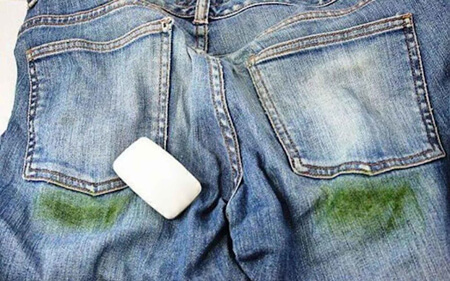
Video: How to Remove Grass Stains from your Clothes

Homemade ways to remove grass stains from jeans
Denim fabric is produced by tightly weaving dyed and undyed threads. Raw materials - pure cotton or cotton with the addition of artificial threads. Before trying to remove grass or grease stains from denim, you need to know the composition of the material.
If there is elastane in the composition, do not use aggressive substances from household use, for example, ammonia, hydrogen peroxide. Contact with such solutions will not get rid of the stain, but will ruin the thing.
Laundry soap
Laundry soap is a must have substance in the household. It is a component of many folk recipes for cleaning clothes. Using laundry soap, you can wash tulle to white, clean plaque on pots, remove grass stains from jeans and other clothes.
The cleaning recipe is simple: the contaminated area is abundantly moistened with hot water, lathered, wiped with a sponge, and aged for half an hour to act. The jeans are then washed in the machine.
Salt
A very simple and effective remedy is trivial salt. Here's how to remove salt stains from jeans:
- prepare a solution, 1 tablespoon of salt per glass of water;
- treat the area with grass spots;
- leave for half an hour.
After these steps, the jeans should be washed in the washing machine in the required mode.
Video: Stain removal: how to remove grass stains from clothes

Boiling water
Boiling water helps to remove fresh grass stains. It must be poured onto the stain and washed immediately.
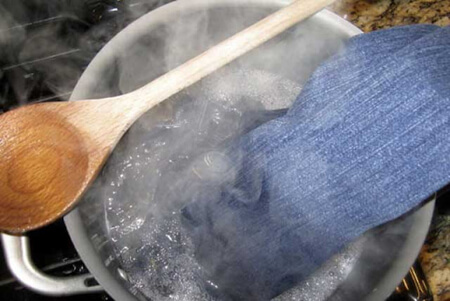
Vinegar
How do I remove a stain with vinegar? Acetic acid dissolves dirt well, helps if the stain is deeply embedded in the fibers. The area with the stain is abundantly moistened with vinegar. Strong dirt can be wiped with a sponge. Clothes are left for an hour, then washed by hand or in a machine.
Soap and ammonia
Ammonia can only be used on light-colored denim. Dark fabrics from contact with the substance may discolor. Action algorithm:
- prepare a solution of 1 tablespoon of ammonia in a glass of water, one tablespoon of grated laundry soap;
- wipe stains with a cotton swab or sponge soaked in the solution;
- leave for 30-40 minutes.
The process ends with a regular machine wash.
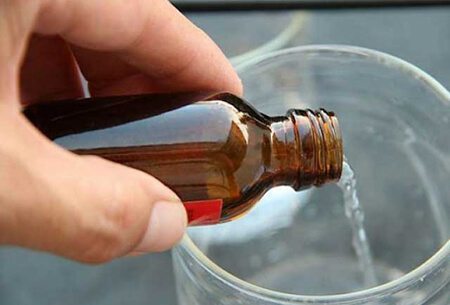
Hydrogen peroxide
How to remove grass from jeans with hydrogen peroxide? The substance can only be used for light-colored denim. Dark jeans can lose color saturation. The stain is watered with hydrogen peroxide on both sides, then washed.
Video: How to remove grass stains from my clothes

Household chemicals
A grass stain on jeans can sometimes not be removed the first time, but do not despair. You can try several methods and succeed. Industrial stain removers should be used only if more gentle folk remedies did not help.
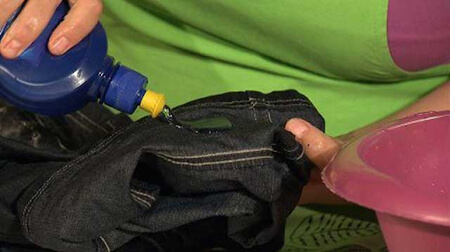
Washing powders
Before washing, you can soak jeans in a regular washing powder for 2 hours. Before laying in the machine, the powder is washed off and the work cycle intended for jeans wear is started.
Stain removers
Specially for stubborn stains, stain removers have been developed. The principle of using the preparations is the same: you should moisten the place of contamination, apply the product, wait for the time according to the instructions and wash the jeans in the desired mode. Good results are shown by the preparations “Amway”, “Vanish”, “Udalix”.
Video: How to Remove Grass Stains, by Claudia Marques

How to wash jeans properly?
The final step in removing stains is washing jeans. The wrong process leads to the loss of the original properties of the fabric. Read the label carefully before washing. Basic rules:
- things turn inside out;
- jeans are washed separately from other linen;
- washing is done in a delicate mode, at a temperature of 30 degrees, spinning 600-800 revolutions. Some models of washing machines have a built-in "Jeans" mode, in which the necessary parameters are preset.
So, there is a risk of staining your favorite jeans in the grass, but there are also effective ways to get rid of stains. There is no reason to refuse the most comfortable clothes for a walk or a picnic and limit yourself in movements, contacts with nature.
Video: Grass Stain Buster - Remove Grass Stains From Clothes and Jeans Pants At Home




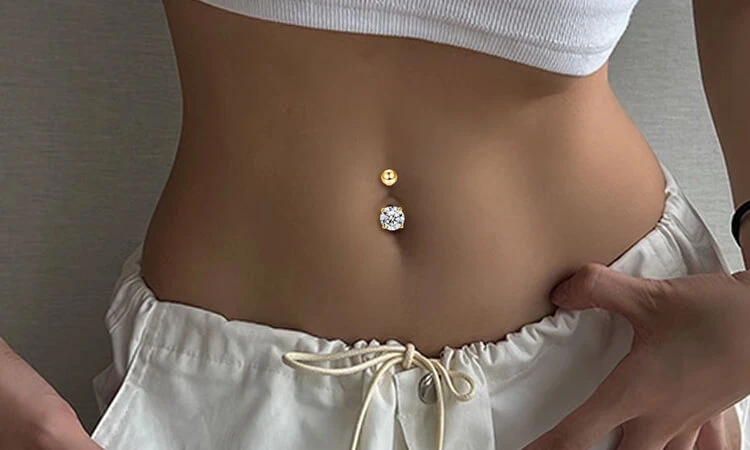





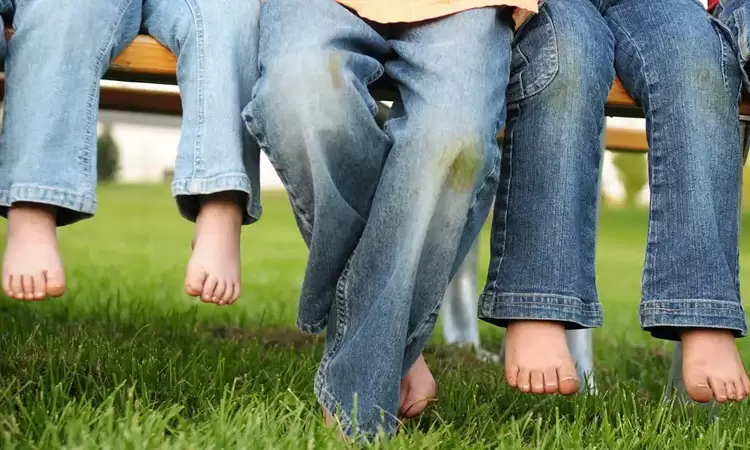






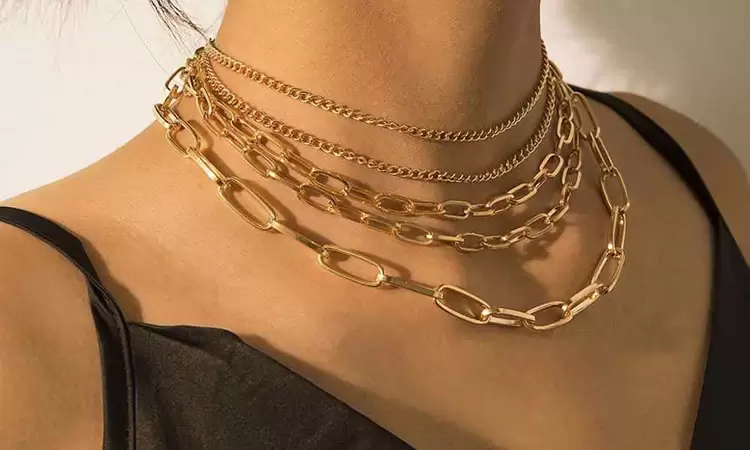
Comments (6)